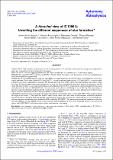Files in this item
A Herschel view of IC 1396 A : unveiling the different sequences of star formation
Item metadata
| dc.contributor.author | Sicilia-Aguilar, Aurora | |
| dc.contributor.author | Roccatagliata, Veronica | |
| dc.contributor.author | Getman, Konstantin | |
| dc.contributor.author | Henning, Thomas | |
| dc.contributor.author | Merin, Bruno | |
| dc.contributor.author | Eiroa, Carlos | |
| dc.contributor.author | Riviere-Marichalar, Pablo | |
| dc.contributor.author | Currie, Thayne | |
| dc.date.accessioned | 2014-08-29T08:31:06Z | |
| dc.date.available | 2014-08-29T08:31:06Z | |
| dc.date.issued | 2014-02-20 | |
| dc.identifier | 144226522 | |
| dc.identifier | ddfdaca7-3ae4-486b-9505-8ba53082df57 | |
| dc.identifier | 000332161800092 | |
| dc.identifier | 84894444605 | |
| dc.identifier | 000332161800092 | |
| dc.identifier.citation | Sicilia-Aguilar , A , Roccatagliata , V , Getman , K , Henning , T , Merin , B , Eiroa , C , Riviere-Marichalar , P & Currie , T 2014 , ' A Herschel view of IC 1396 A : unveiling the different sequences of star formation ' , Astronomy & Astrophysics , vol. 562 , A131 . https://doi.org/10.1051/0004-6361/201322609 | en |
| dc.identifier.issn | 0004-6361 | |
| dc.identifier.uri | https://hdl.handle.net/10023/5285 | |
| dc.description | A.S.A. acknowledges support from the Spanish MICINN/MINECO “Ramón y Cajal” program, grant number RYC-2010-06164, and the action “Proyectos de Investigación fundamental no orientada”, grant number AYA2012-35008. C.E. is partly supported by Spanish MICINN/MINECO grant AYA2011-26202. V.R. is supported by the DLR grant number 50 OR 1109 and by the Bayerischen Gleichstellungsförderung (BGF). | en |
| dc.description.abstract | Context. The IC 1396 A globule, located to the west of the young cluster Tr 37, is known to host many very young stars and protostars, and is also assumed to be a site of triggered star formation. Aims. Our aim is to test the triggering mechanisms and sequences leading to star formation in Tr 37 and similar regions. Methods. We mapped IC 1396 A with HerscheI/PACS at 70 and 160 μm. The maps reveal the structure of the most embedded parts of the star-forming site in great detail. Results. The HerscheI/PACS maps trace the very embedded protostellar objects and the structure of the cloud. PACS data reveal a previously unknown Class 0 object, labeled IC 1396 A-PACS-1, located behind the ionization front. IC 1396 A-PACS-1 is not detectable with Spitzer, but shows marginal X-ray emission. The data also allow the study of three of the Class I intermediate-mass objects within the cloud. We derived approximate cloud temperatures to study the effect and potential interactions between the protostars and the cloud. The Class 0 object is associated with the densest and coldest part of IC 1396 A. Heating in the cloud is dominated by the winds and radiation of the 06.5 star HD 206267 and, to a lesser extent, by the effects of the Herbig Ac star V 390 Cep. The surroundings of the Class I and Class II objects embedded in the cloud also appear warmer than the sourceless areas, although most of the low-mass objects cannot be individually extracted owing to distance and beam dilution. Conclusions. The observations suggest that at least two episodes of star formation have occurred in IC 1396 A. One would have been the origin of the known, similar to ~1 Myr-old Class I and II objects in the cloud, and a new wave of star formation would have produced the Class 0 source at the tip of the bright-rimmed cloud. From its location and properties, IC 1396 A-PACS-1 is consistent with having been triggered via radiative driven implosion (RDI) induced by HD 206267. The mechanisms behind the formation of the more evolved population of Class objects in the cloud are uncertain. Heating of most of the remaining cloud by Class I/Class II objects and by HD 206267 itself may preclude further star formation in the region. | |
| dc.format.extent | 9 | |
| dc.format.extent | 28777663 | |
| dc.language.iso | eng | |
| dc.relation.ispartof | Astronomy & Astrophysics | en |
| dc.subject | Stars: formation | en |
| dc.subject | Stars: protostars | en |
| dc.subject | Stars: pre-main sequence | en |
| dc.subject | ISM: clouds | en |
| dc.subject | ISM: individual objects: IC 1396 A | en |
| dc.subject | Open clusters and associations: individual: Trumpler 37/Tr37 | en |
| dc.subject | Bright-rimmed clouds | en |
| dc.subject | Radiation-driven implosion | en |
| dc.subject | Far-infrared observations | en |
| dc.subject | Intermediate-mass stars | en |
| dc.subject | Elephant trunk nebula | en |
| dc.subject | Iras point sources | en |
| dc.subject | Disk evolution | en |
| dc.subject | X-ray | en |
| dc.subject | Molecular cloud | en |
| dc.subject | Cepheus B | en |
| dc.subject | QB Astronomy | en |
| dc.subject.lcc | QB | en |
| dc.title | A Herschel view of IC 1396 A : unveiling the different sequences of star formation | en |
| dc.type | Journal article | en |
| dc.contributor.institution | University of St Andrews. School of Physics and Astronomy | en |
| dc.identifier.doi | https://doi.org/10.1051/0004-6361/201322609 | |
| dc.description.status | Peer reviewed | en |
| dc.identifier.url | http://adsabs.harvard.edu/abs/2014A%26A...562A.131S | en |
This item appears in the following Collection(s)
Items in the St Andrews Research Repository are protected by copyright, with all rights reserved, unless otherwise indicated.

